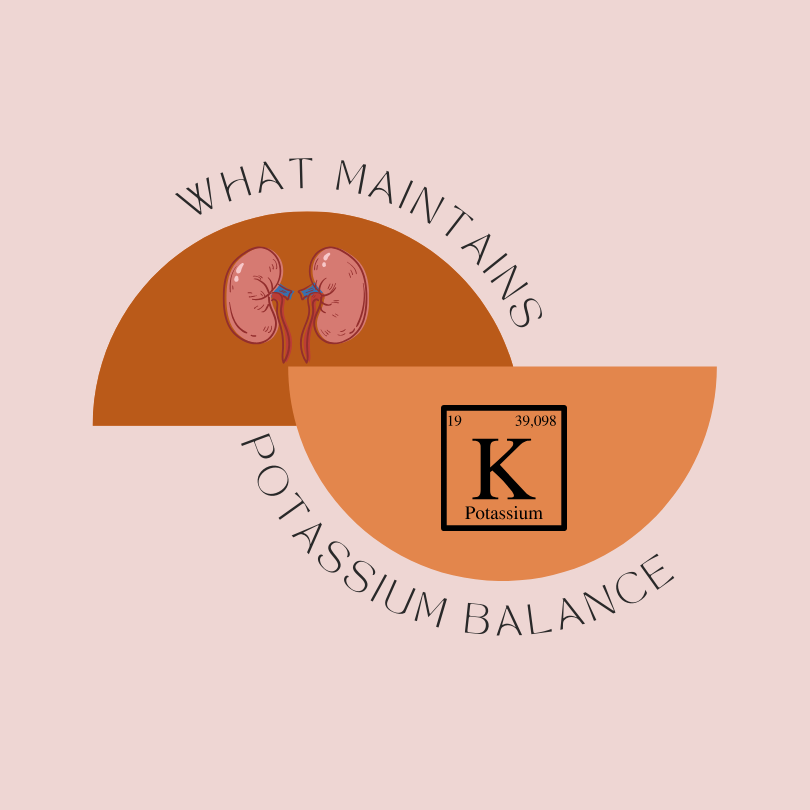Love all things potassium? Me too! So today I am writing a bit more about the nitty gritty for potassium.
This post is a summary of this article, which I wrote about in this post. But there was so much excellent potassium homeostasis information in the article too, that I wanted to get a summary of it here for all my keen bean readers (and myself to refer back to!)
Where is potassium found in the body?
Most of the potassium (98%) in the body is found within the intra-cellular fluid. And most of it is found in the muscle cells. The muscle cells store large amounts of fluid, which is why it can also store large amounts of potassium.
The remaining amount of potassium (2%) is in the extra-cellular fluid. Which in clinical practice we tend to refer to as the serum or blood. In my experience, in clinical practice we use the term serum and blood interchangeably, though there is a slight difference.
How much potassium is in the body?
In the intra-cellular fluid, there is approximately 3000mmol of potassium. In the extra-cellular fluid there is about 65mmol. Because this difference is so big, a release of 1% of potassium from the intra-cellular fluid to the extra-cellular fluid will increase the extra-cellular concentration by ~50%!
What mechanisms keep the potassium inside the cells?
The high concentration of potassium inside the cells is maintained by Sodium-Potassium ATPase pumps (Na-K-ATPase pumps). This pump uses energy to trade three sodium ions from inside the cell for two potassium irons from outside the cell.

What hormones are involved in potassium homeostasis?
Hormones is the word used to describe how one part of the body communicates with another part. I think of it like the body’s text message system. For example, the hormone insulin is secreted from the pancreas, and it can be used to send a message to the muscle cell to tell it what to do.
The two main hormones that work on NaKATPase pumps are:
- Insulin (for more about insulin and potassium – check out this post)
- Adrenaline
Both stimulate NaKATPase expression (which means they turn on the pumps) and increase the entry of potassium into the cells.
How does adrenaline stimulate potassium uptake?
Adrenaline is active during activity or stress.
During exercise, potassium is released from muscle and nerve cells to trigger action potentials. Adrenaline is the counter-action for this process. Adrenaline increase NaKATPase activity to stimulate potassium uptake into cells.
During stress, specifically tissue damage and cell death, potassium is released from cells due to losses of barrier function. The cells can’t keep the concentration gradients active because they are damaged. Adrenaline will try to help keep the potassium regulated by turning on the NaKATPase pumps in other parts of the body to try to force more of those cells to take up the extra potassium.
What parts of the kidney handle potassium?

Figure 2 of the article highlights three main parts in the kidney that handle potassium, with:
- 65% reabsorbed in the proximal convoluted tubule
- 25% reabsorbed in the thick ascending limb
- 10% reabsorbed in the collecting duct
The collecting ducts are unique because here potassium can be either reabsorbed or secreted based on the physiological needs of the body.
How much potassium is filtered by the kidneys?
A filtration rate of 100 means that roughly 145-150L of plasma is filtered through the kidneys every day!! Wow that’s a lot.
If the serum potassium is at 4mEq/L then 600mEq of potassium per day is being filtered (4 * 150 = 600). Normal potassium excretion is reported to be 70-75mEq per day in health adults.
Why does all of this matter?
In order for us to understand why hyperkalemia might develop in our patients it is important to have a basic understanding of what should normally be happening in the kidneys.
If you have a patient with altered hormone levels (related to either a disease process or medications) that impact potassium, then this may explain why their potassium is harder to control.
Additionally, if you have patient who has a disease process that may be impacting a specific section of the kidney that is normally involved in maintaining potassium homeostasis, again this may explain what is happening with their potassium.
Take Aways
Several hormone, pumps and parts of the kidneys are involved in maintaining normal serum potassium levels. Changes in any one of these systems can impact potassium balance and may contribute to hyperkalemia.




2 thoughts on “What maintains potassium balance?”